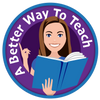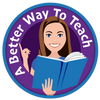Fact: storytelling is powerful. Everyone loves a good story.
I just finished reading Kindra Hall’s book Stories That Stick, so I’ve got storytelling on my mind. Though Hall’s book is mainly intended for business owners, I found the concepts applicable to every area of life because storytelling is powerful no matter what you do for a living.
If you are an English teacher, I imagine that part of what brought you to the classroom has to do with the power of story. Maybe you are a great oral storyteller or a great writer, or maybe you just love reading a good story. I imagine, on some level, you wanted to bring the power of story to students and that, at least in some way, guided you to become an English teacher.
But there is sooooo much we have to cover in the high school English classroom--how to analyze literature, how to write a persuasive paper, how to become digitally literate…the list goes on.
The job is big--the ask is demanding.
But when you and your students are feeling burned out, I’d like to suggest a story reset.
What’s A Story Reset?
A classroom reset is basically pushing the “reset” button by giving your students a chance to focus or refocus on something besides the day-to-day tasks that are at hand. A story reset allows your students to refocus on story (and all the power and beauty that comes with it), in order to remember how good stories are for the soul.
Drop the highlighters and set aside your compulsion to relentlessly annotate the heck out of a novel. Just sit back, and enjoy a story.
I’m going to give you 7 ways you can do this. They range from taking a few minutes of your class period, to taking a few days.
Idea #1: Listen To An Episode of “The Moth” Podcast
It’s no secret that I adore The Moth podcast. If you’re not familiar with the show, in each episode there are about 3-4 stories that regular people tell about their regular lives. But every story I’ve heard is so powerful.
The Moth uses a storytelling framework to draw the listener in from the very beginning. There’s no fluff, no rambling. Every story packs a punch, and I’m always amazed by how much meaning is relayed in such a short amount of time.
Each story is about 5-12 minutes, which makes it a great way to start your class period. Short on planning time? Just your students listen to a story, and then simply do a free write about what stood out to them about the story.
This doesn’t have to be a high-stakes analysis. Just allow students to listen and respond. Here are a few questions they can journal about after listening to a story:
- What stood out to you about this story?
- What is one thing you were able to imagine when this person was telling their story?
- Did you connect to anything in the story?
- How did the story end?
- How did this story make you feel? How do you think the author got you to feel that way?
No matter what content you are teaching right now, spending a few minutes listening to a Moth episode can allow students to recenter on how and why good storytelling happens.
Here are a few episodes to start with:
- Outdoor Camp-A homeless teen gets a chance to go to an outdoor camp and he tells about his conflicting feelings about leaving his family for the week.
- Colors of Love- Andrew Brown comes face to face with his academic nemesis
Here are a few more episodes you can check out that are geared toward teens.
Idea #2: Use Published Sentences For Story Starters
A few years ago I whipped up some bell ringers that focus on writing craft and grammar review. One of the strategies I use in the bell ringers is to give students a sentence from a published work and I have them continue a story with that sentence as the starting point.
It's a low-stakes way to allow kids to get some creative writing in, a practice that often gets left out in all the other things we need to do in the high school English classroom.
You can also add some more specifics, such as "write the rest of the story, but use only simple sentences to see what effect you create."
Idea #3: Do Fill-In-The-Blank Stories
This takes about 10 minutes of class time, and allows your students to review grammar concepts in the context of story.
The concept is straightforward: students have a pre-printed story with certain nouns, verbs, adjectives, and adverbs missing. They'll ask a partner for an adjective (for instance) and their partner might say "gorgeous." They fill it into the story.
Once all the blanks are filled in, they have created a bizarre (and hilarious) story (of sorts).
Ok, this might not be "story" in the strictest sense of the word, but it's story-like, and it's a lot of fun. It can serve as a great reset for your students, and give them a chance to laugh a little.
I've put together a bunch of these pre-made stories, and you can check them all out when you join the English Teacher Vault community! For more info click here!
Alternatively, you can have your students write their own "Mad-Libs" style stories by writing a story, then taking out a few nouns, verbs, and adjectives and having a partner fill those in. This site can walk your students through how to write their own mad-libs style story.
Idea #3: Take A Class Period To Write Brainstorm Your Story With Picture Prompts
Personal narratives are one of the most meaningful types of writing our students can do. It's a form of writing that they will use later in life in various forms for various purposes, so I find it meaningful to revisit the personal narrative every singe year in high school.
Inevitably, students have a hard time deciding on a topic about which to write, but there are a few ways you can help students realize they have LOTS of stories rattiling around in their brains.
In her book, Stories That Stick, Kindra Hall suggests zeroing in on the nouns in your life.
Write down people's names, places you've lived, places you've visited, jobs you've had, etc. Focus on nouns, and make a list. Then brainstorm memories related to those nouns. I love that strategy.
A similar strategy is to give students images of nouns and have them brainstorm any memories they can connect with those images.
I find the following images can relate to lots of teens:
- a moving van
- a fork in a road/path
- a treehouse/fort/swingset
- an ambulance
- a common food like pizza or spaghetti
I have a lesson that walks you through exactly how to do this and includes a curated collection of images that can grab when you become a member of the English Teacher Vault! Or find your own on a site like Pexels.com.
Idea #4: Play Storymatic Or Another Storytelling Game
Storymatic is a fantastic game for the high school English classroom. Basically, the game consists of hundreds of cards with characters on conflicts on them. Students will draw cards that give them a character and one trait about that character (i.e. a boxer with a devastating secret).
Then, students will draw cards that include objects, places, and complications that will help get the story started.
The only rules of the game: you can't kill your character off, and the main character must change in some way.
You can play the game any number of ways--individually, in pairs, or in groups, depending on your situation.
It's a fun activity to get the creative juices flowing in a low-stakes way. If students get stuck you can give them another conflict card or character card to get them thinking.
Idea #6: Listen To An Imagined Life Podcast Episode
I love the Imagined Life podcast for LOTS of reasons, which I've written about in other places. Check out this blog post on "3 Podcasts That Work In High School English" to find out more.
In short--these are riveting stories about real people, but you don't know who the famous person is until the end of the episode. You've got to guess along the way by thinking about the well-placed clues in each episode.
The episodes use lots of storytelling devices, and they're a fun mix of fiction and nonfiction.
Plus, each episode is a stand-alone story, so you can use one for a class period any time, and shoot, you could even use it as sub plans.
If you want more on how to incorporate this in your classroom, grab everything you need when you become a member of the English Teacher Vault!
Idea #7: Create A Story By Connecting Picture Prompts
I do love some handheld picture prompts.
One way to use these are in the brainstorming process of narrative writing (explained above). Another way is to give students a collection of curated pictures and set a timer for 15 minutes.
Have them connect 3 images into a story. See what happens!
If you want to then have students refine these stories, feel free to do that to take it further.
I include this activity in my lessons for the first week of school to informally gauge students' writing abilities. You can grab that lesson here.
Takeaways:
When you or your students need a change of pace, do a story "reset" period or even a few minutes at the beginning of class to remember how awesome stories are.
If you only have a few minutes, listen to a "Moth" episode or do a "Mad Libs" style activity.
If you have more time to work with, listen to an Imagined Life episode, play a game like Storymatic, or have students make their own stories inspired by picture prompts.
Related Reading
ELA Teachers, I Planned Your Last Week Before Exams
Have Stressed Students? Let Them Rest.
5 Amazing Reasons To Teach Short Story Analysis At The Beginning Of The Year













Leave a comment